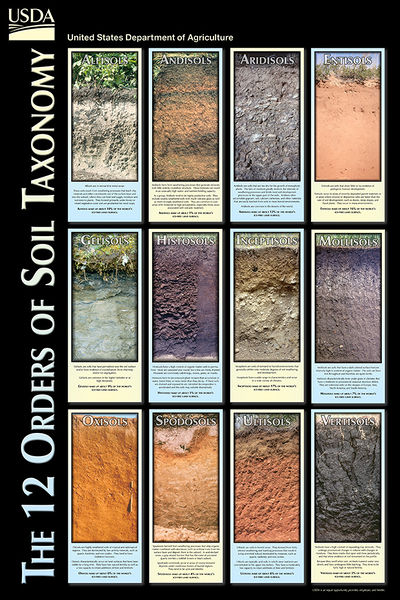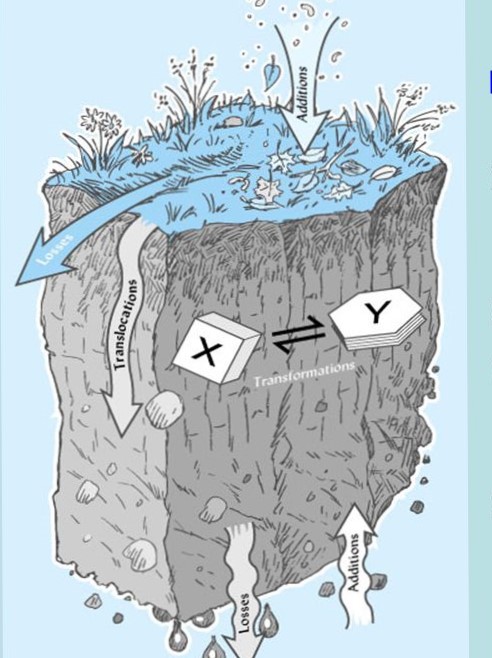Soil processes: Difference between revisions
No edit summary |
m The LinkTitles extension automatically added links to existing pages (<a rel="nofollow" class="external free" href="https://github.com/bovender/LinkTitles">https://github.com/bovender/LinkTitles</a>). |
||
| (30 intermediate revisions by 2 users not shown) | |||
| Line 1: | Line 1: | ||
'''[[Soil]] | =='''Soil Processes'''== | ||
[[File:Nrcs.jpg|400px|right|thumb|Image 1: 12 soil groups: [6]]] | |||
[[Soil]] processes are specific changes to a soil influencing the relationship between soil and its ecosystem, landscape, flora, and fauna [2]. One key component of soil processes is the formation of soil. The climate, topography (relief/slope), parent material (origin of soil particles), and time. This is described within the [[Jenny Equation]]. Based on the formation processes and the different horizons of soil layers, a soil sample may be classified into 12 soil orders according to a Soil taxonomy[6]. | |||
[[File:Four+basic+processes+of+soil+formation .jpg|right]] | |||
=='''Types of Soil Processes''' == | |||
'''Soil Processes''' | |||
'''1: Additions:''' Adding material to the soil helps build [[Soil Horizons|soil horizons]]. Materials can be made up of detritus (organic material), atmospheric dust, or soluble salts from groundwater [2]. | '''1: Additions:''' Adding material to the soil helps build [[Soil Horizons|soil horizons]]. Materials can be made up of detritus (organic material), atmospheric dust, or soluble salts from groundwater [2]. | ||
'''2: Translocations:''' Transportation of materials (organic or inorganic) between soil horizon layers either up or down. | '''2: Translocations:''' Transportation of materials (organic or inorganic) between soil horizon layers either up or down. This is primarily water-driven, however, on a small scale fauna can have great influence. | ||
'' | ''Pedoturbation'' is the term for the mixing of soils. | ||
Fauna translocators examples: | Fauna translocators examples: [[earthworm]]s, ants, [[moles]], rodents. | ||
Flora translocators occur when blowdown trees uproot. The root ball exposes new [[Soil Horizons|soil horizons]] to the surface and | Flora translocators occur when blowdown trees uproot. The root ball exposes new [[Soil Horizons|soil horizons]] to the surface and provides an opportunity for seeds to germinate. Eventually, this blown-down tree will create pit and mound features in a forest [2]. | ||
Algillic pedoturbation occurs with the mixing of clays through churning processes called sink-swell cycles. These cycles are dominated by moisture and when dry, clays will crack allowing for lower horizons to be exposed to new materials [3]. | Algillic pedoturbation occurs with the mixing of clays through churning processes called sink-swell cycles. These cycles are dominated by moisture and when dry, clays will crack allowing for lower horizons to be exposed to new materials [3]. | ||
'''3: Transformations:''' Transferring soil constituents from one form to another. Ex: Mineral weathering and organic matter | '''3: Transformations:''' Transferring soil constituents from one form to another. Ex: Mineral weathering and [[Organic Matter|organic matter]] breakdown. | ||
'' | ''Humification:'' This is the process in which dead organic material or soil additions (leaves, detritus, woody matter) are converted to [[humus]] by [[decomposers]] such as bacteria and fungi. Humus is a dark black gel-like substance. Dark soils (brown/black) are usually high in humus concentration. Humus affects the crumb [[Soil Structures]] of soil particles which affect the amount of pore space. Humus also affects the amount of water held in soil within the pore spaces. Humification tends to keep a neutral [[soil pH]] that is suitable for most [[microorganisms]] [4]. | ||
'' | ''Weathering:'' This is the breakdown of rocks or minerals into smaller pieces through chemical or physical processes. Physical weathering includes mechanisms such as freezing and thawing, wind erosion, and water erosion. These processes influence the soil's pH, water content, texture, and structure. Physical weathering creates smaller particles that provide mineral content to the soil. Chemical weathering through oxidation, carbonation, and hydrolysis either creates or destroys minerals thus altering the soil's mineral composition. Oxidation yields different soil colors such as orange/red soil from the oxidation of iron within the soil. Carbonation is a reaction with carbonic acid which breaks down or dissolves rocks and minerals. Hydrolysis is a reaction with water helping minerals and rocks become less resistant to weathering (Soil Genesis and Development). | ||
'''4: Losses:''' This final group includes the loss of material from either leaching processes via groundwater or surface erosion (wind, water, anthropogenic actions) [2]. | |||
=='''References'''== | |||
[1] Fairman, Patrick. “Soil Formation Begins with Weathering of [[Bedrock]].” SlidePlayer, 19 July 2017, slideplayer.com/slide/3843414/. | [1] Fairman, Patrick. “Soil Formation Begins with Weathering of [[Bedrock]].” SlidePlayer, 19 July 2017, slideplayer.com/slide/3843414/. | ||
Latest revision as of 13:09, 10 May 2023
Soil Processes

Soil processes are specific changes to a soil influencing the relationship between soil and its ecosystem, landscape, flora, and fauna [2]. One key component of soil processes is the formation of soil. The climate, topography (relief/slope), parent material (origin of soil particles), and time. This is described within the Jenny Equation. Based on the formation processes and the different horizons of soil layers, a soil sample may be classified into 12 soil orders according to a Soil taxonomy[6].

Types of Soil Processes
1: Additions: Adding material to the soil helps build soil horizons. Materials can be made up of detritus (organic material), atmospheric dust, or soluble salts from groundwater [2].
2: Translocations: Transportation of materials (organic or inorganic) between soil horizon layers either up or down. This is primarily water-driven, however, on a small scale fauna can have great influence.
Pedoturbation is the term for the mixing of soils.
Fauna translocators examples: earthworms, ants, moles, rodents.
Flora translocators occur when blowdown trees uproot. The root ball exposes new soil horizons to the surface and provides an opportunity for seeds to germinate. Eventually, this blown-down tree will create pit and mound features in a forest [2].
Algillic pedoturbation occurs with the mixing of clays through churning processes called sink-swell cycles. These cycles are dominated by moisture and when dry, clays will crack allowing for lower horizons to be exposed to new materials [3].
3: Transformations: Transferring soil constituents from one form to another. Ex: Mineral weathering and organic matter breakdown.
Humification: This is the process in which dead organic material or soil additions (leaves, detritus, woody matter) are converted to humus by decomposers such as bacteria and fungi. Humus is a dark black gel-like substance. Dark soils (brown/black) are usually high in humus concentration. Humus affects the crumb Soil Structures of soil particles which affect the amount of pore space. Humus also affects the amount of water held in soil within the pore spaces. Humification tends to keep a neutral soil pH that is suitable for most microorganisms [4].
Weathering: This is the breakdown of rocks or minerals into smaller pieces through chemical or physical processes. Physical weathering includes mechanisms such as freezing and thawing, wind erosion, and water erosion. These processes influence the soil's pH, water content, texture, and structure. Physical weathering creates smaller particles that provide mineral content to the soil. Chemical weathering through oxidation, carbonation, and hydrolysis either creates or destroys minerals thus altering the soil's mineral composition. Oxidation yields different soil colors such as orange/red soil from the oxidation of iron within the soil. Carbonation is a reaction with carbonic acid which breaks down or dissolves rocks and minerals. Hydrolysis is a reaction with water helping minerals and rocks become less resistant to weathering (Soil Genesis and Development).
4: Losses: This final group includes the loss of material from either leaching processes via groundwater or surface erosion (wind, water, anthropogenic actions) [2].
References
[1] Fairman, Patrick. “Soil Formation Begins with Weathering of Bedrock.” SlidePlayer, 19 July 2017, slideplayer.com/slide/3843414/.
[2] Krzic M., P. Sanborn, K. Watson, A.A. Bomke, C. Crowley, A. Doree, and S. Dyanatkar. 2008. Soil formation and soil processes. The University of British Columbia, Vancouver, University of Northern British Columbia, and Thompson Rivers University, Kamloops. [ http://processes.soilweb.ca/ ]
[3] “K-State Research and Extension.” Clay Soil: It Shrinks and Swells, 21 Nov. 2016, www.johnson.k-state.edu/lawn-garden/agent-articles/miscellaneous/shrink-swell-clay-soils.html.
[4] “Natural Processes and Soil.” Leaving Certificate Geography, lcgeography.preswex.ie/natural-processes-and-soil.html. “Natural Resources Conservation Service.” Soil Formation and Classification |
[5] NRCS Soils, NRCS, www.nrcs.usda.gov/wps/portal/nrcs/detail/soils/edu/?cid=nrcs142p2_054278.
[6] “Natural Resources Conservation Service.” The Twelve Orders of Soil Taxonomy | NRCS Soils, www.nrcs.usda.gov/wps/portal/nrcs/detail/soils/edu/?cid=nrcs142p2_053588. st
[7] “Soil Genesis and Development, Lesson 2 - Processes of Weathering.” Plant and Soil Sciences ELibrary, passel.unl.edu/pages/informationmodule.php?idinformationmodule=1124303183&topicorder=4&maxto=7.
[8] “Soil Genesis and Development, Lesson 4 - Soil Profile Development.” Plant and Soil Sciences ELibrary, 2018, passel.unl.edu/pages/informationmodule.php?idinformationmodule=1130447025&topicorder=3&maxto=5.